En
The Guide to Digital Photography
with the
DIGITAL CAMERA
E
n
Printed in Japan
S2BB000201(11)
6MAA1511-02
�
Shoot, View, and Enjoy
A Flowchart Guide to Using Your Camera
STEP 1—Ready the camera
Getting ready
Camera setup
STEP 2—Take pictures
First Steps
First Steps
Camera Setup
Snapshots (auto mode)
Creative photography
(scene mode)
Custom shots and movies
Tutorial: Taking Pictures
Getting Creative
Taking Pictures: The Details
STEP 3—Play them back…
…while shooting…
…after shooting…
Review and Deletion
Basic Playback
…and delete unwanted pictures…
…immediately
…while shooting
…during playback
Delete multiple pictures
Keep or Delete
Review and Deletion
Basic Playback
Deleting Pictures
16
16
69
24
36
51
31
78
58
31
78
86
STEP 4—Install camera software
Install software
Get to know Nikon View 5
Quick Start Guide (provided)
Nikon View 5 Reference
Manual (provided on CD)
—
—
STEP 5—Copy pictures to your computer
Transfer pictures
Connections
41
�
Product Documentation
The documentation for this product
includes the manuals listed below.
Please be sure to read all instructions
thoroughly to get the most from your
camera.
Quick-Start Guide
The Quick-Start Guide takes you
through the process of unpacking
and setting up your Nikon digital
camera, taking your first pictures, in-
stalling software, and transferring
pictures to your computer.
Guide to Digital Photography
The Guide to Digital Photography
(this manual) provides complete op-
erating instructions for your camera.
Nikon View 5 Reference Manual
The Nikon View 5 Reference Manual
can be found in electronic format
on the reference CD provided with
your camera. For information on
viewing the Reference Manual, see
“Connections” in this manual.
Overview
Getting to Know the COOLPIX 2500
Menu Guide
First Steps
Taking Pictures
Review and Deletion
Getting Creative
Connections
Beyond Point-and-Shoot
Fine-Tuning Camera Settings
Camera Setup
Basic Playback
The Playback Menu
Technical Notes
Index
i
�
For Your Safety
To prevent damage to your Nikon product or injury to yourself or to others,
read the following safety precautions in their entirety before using this equip-
ment. Keep these safety instructions where all those who use the product
will read them.
The consequences that could result from failure to observe the precautions
listed in this section are indicated by the following symbol:
This icon marks warnings, information that should be read before us-
ing your Nikon product to prevent possible injury.
WARNINGS
Turn off immediately in the event
of malfunction
Should you notice smoke or an un-
usual smell coming from the equip-
ment or from the AC adapter (avail-
able separately), unplug the AC
adapter or remove the battery imme-
diately, taking care to avoid burns.
Continued operation could result in
injury. After removing the battery,
take the equipment to a Nikon-autho-
rized service center for inspection.
Do not use in the presence of flam-
mable gas
Do not use electronic equipment in
the presence of flammable gas, as this
could result in explosion or fire.
Observe caution when using the
camera strap
Caution should be exercised to pre-
vent strangulation when wearing the
camera strap around your neck. Never
place the strap around the neck of an
infant or child.
ii
Do not disassemble
Touching the product’s internal parts
could result in injury. In the event of
a malfunction, the product should be
repaired only by a qualified technician.
Should the product break open as the
result of a fall or other accident, re-
move the battery or AC adapter and
then take the product to a Nikon-au-
thorized service center for inspection.
Observe proper precautions when
handling batteries
Batteries may leak or explode if im-
properly handled. Observe the follow-
ing precautions when handling bat-
teries for use in this product:
• Be sure the product is off before re-
placing the battery. If you are using
an AC adapter, be sure it is un-
plugged.
• Use only a rechargeable Nikon EN-EL2
lithium-ion battery (supplied).
• When inserting the battery, do not at-
tempt to insert it upside down or
backwards.
• Do not short or disassemble the bat-
tery.
• Do not expose the battery to flame
or to excessive heat.
• Do not immerse in or expose to water.
• Do not transport or store with metal
objects such as necklaces or hairpins.
�
• Immediately after use, or when the
product is used on battery power for
an extended period, the battery may
become hot. Before removing the
battery, turn the camera off and al-
low the battery to cool.
• Discontinue use immediately should
you notice any changes in the battery,
such as discoloration or deformation.
Use appropriate cables
When connecting cables to the input
and output jacks, use only the cables
provided or sold by Nikon for the pur-
pose, to maintain compliance with
product regulations.
The lens section
• Do not insert your fingers in the gap
between the rotating lens section and
the camera body. Your fingers could
be pinched between the body and the
lens section, resulting in injury. Par-
ticular care should be observed in the
case of small children.
• Batteries are prone to leakage when
fully discharged. To avoid damage to
the product, be sure to remove the
battery when no charge remains.
• When the battery is not in use, attach
the terminal cover and store in a cool
place.
• To prevent your fingers, flesh, or other
objects from being pinched in the gap
between the rotating lens section and
the camera body, return the lens sec-
tion to its housing in the camera body
before transporting the camera.
Keep out of reach of children
Particular care should be taken to pre-
vent infants from putting the battery
or other small parts into their mouths.
Removing memory cards
Memory cards may become hot dur-
ing use. Observe due caution when
removing memory cards from the
camera.
CD-ROMs
The CD-ROMs on which the software
and manuals are distributed should
not be played back on audio CD
equipment. Playing CD-ROMs on an
audio CD player could cause hearing
loss or damage the equipment.
Observe caution when operating
the flash
Using the flash close to your subject’s
eyes could cause temporary visual im-
pairment. Particular care should be
observed if photographing infants,
when the flash should be no less than
one meter (39˝) from the subject.
Avoid contact with liquid crystal
Should the monitor break, care should
be taken to avoid injury due to bro-
ken glass and to prevent liquid crystal
from the monitor touching the skin
or entering the eyes or mouth.
iii
�
Caring for the Camera and Battery
Keep dry
This product is not waterproof, and may
malfunction if immersed in water or ex-
posed to high levels of humidity. Rusting
of the internal mechanism can cause irrepa-
rable damage.
Keep free of salt, sand, and dust
After using your camera at the beach or
seaside, wipe off any sand or salt with a
lightly dampened cloth and then dry your
camera thoroughly.
Do not touch the lens with your fingers
The proper procedure for cleaning the lens
is described in “Technical Notes: Caring for
Your Camera.”
Handle the lens and all moving parts
with care
Do not apply force to the lens or to the
battery, card, and connector covers. These
parts are especially susceptible to damage.
Turn the product off before removing
the battery or unplugging the AC
adapter
Do not unplug the product or remove the
battery while the product is on, or while
images are being recorded or deleted.
Forcibly cutting power to the product in
these circumstances could result in loss of
data or in damage to product memory or
internal circuitry. To prevent an accidental
interruption of power, avoid carrying the
product from one location to another while
the AC adapter is connected.
Do not drop
The product may malfunction if subjected
to strong shocks or vibration.
iv
Keep away from strong magnetic fields
Do not use or store this device in the vicin-
ity of equipment that generates strong
electromagnetic radiation or magnetic
fields. Strong static charges or the mag-
netic fields produced by equipment such
as radio transmitters could interfere with
the monitor, damage data stored on the
memory card, or affect the product’s inter-
nal circuitry.
Avoid sudden changes in temperature
Sudden changes in temperature, such as
occur when entering or leaving a heated
building on a cold day, can cause conden-
sation inside the device. To prevent con-
densation, place the device in a carrying
case or a plastic bag before exposing it to
sudden changes in temperature.
Notes on the monitor
• The monitor may contain a few pixels that
are always lit or that do not light. This is
a characteristic common to all TFT LCD
monitors and does not indicate a mal-
function. Images recorded with the prod-
uct will not be affected.
• Images in the monitor may be difficult to
• Do not apply pressure to the monitor, as
this could cause damage or malfunction.
Dust or lint adhering to the monitor can
be removed with a blower brush. Stains
can be removed by rubbing the surface
lightly with a soft cloth or chamois
leather.
• Should the monitor break, care should
be taken to avoid injury due to broken
glass and to prevent the liquid crystal
from the monitor touching the skin or
entering the eyes or mouth.
see in a bright light.
• The monitor is lit by an LED backlight.
Should the monitor begin to dim or
flicker, contact your Nikon service repre-
sentative.
�
Storage
• To prevent mold or mildew, store the
camera in a dry, well-ventilated area. If
you will not be using the product for long
periods, remove the battery to prevent
leakage and store the camera in a plastic
bag containing a desiccant. Do not, how-
ever, store the camera case in a plastic
bag, as this may cause the material to
deteriorate. Note that desiccant gradu-
ally loses its capacity to absorb moisture
and should be replaced at regular inter-
vals.
• Do not store the camera with naphtha
or camphor moth balls, close to equip-
ment that produces strong magnetic
fields, or in areas subject to extremes of
temperature, for example near a space
heater or in a closed vehicle on a hot day.
• To prevent mold or mildew, take the cam-
era out of storage at least once a month.
Turn the camera on and release the shut-
ter a few times before putting the cam-
era away again.
• Store the battery in a cool, dry place.
Smear
When you frame bright subjects, vertical
comet-like streaks that whiten toward ei-
ther end may appear in the monitor. This
phenomenon, known as “smear,” does not
appear in the final photograph and does
not indicate a malfunction. Some smear-
ing may appear in movies.
Batteries
• When you turn the device on, check the
battery-level displayed in the monitor to
determine whether the battery needs to
be replaced. The battery needs to be re-
placed when the battery-level indicator
is flashing.
• Ready a spare battery and keep it fully
charged when taking pictures on impor-
tant occasions. Depending on your lo-
cation, you may find it difficult to pur-
chase replacement batteries on short
notice.
• On cold days, the capacity of batteries
tends to decrease. Be sure the battery is
fully charged before taking pictures out-
side in cold weather. Keep a spare bat-
tery in a warm place and exchange the
two as necessary. Once warmed, a cold
battery may recover some of its charge.
• Should the battery terminals become
dirty, wipe them off with a clean, dry cloth
before use.
Memory cards
• Turn the power off before inserting or re-
moving memory cards. Inserting or re-
moving cards with the power on could
render them unusable.
• Insert memory cards
as shown in the illus-
tration at right. In-
serting cards upside
down or backwards
could damage the
camera or the card.
v
�
Notices
• No part of the manuals included with this product may be reproduced,
transmitted, transcribed, stored in a retrieval system, or translated into any
language in any form, by any means, without Nikon’s prior written permis-
sion.
• Nikon reserves the right to change the specifications of the hardware and
software described in these manuals at any time and without prior notice.
• Nikon will not be held liable for any damages resulting from the use of this
product.
• While every effort has been made to ensure that the information in these
manuals is accurate and complete, we would appreciate it were you to
bring any errors or omissions to the attention of the Nikon representative
in your area (address provided separately).
Notice for customers in Canada
CAUTION
This class B digital apparatus meets all requirements of the Canadian Interfer-
ence Causing Equipment Regulations.
ATTENTION
Cet appareil numérique de la classe B respecte toutes les exigences du Règle-
ment sur le matériel brouilleur du Canada.
A Note on Electronically-Controlled Cameras
In extremely rare instances, unusual characters may appear in the monitor and the
camera may stop functioning. In most cases, this phenomenon is caused by a strong
external static charge. Turn the camera off, remove and replace the battery, and turn
the camera on again, or, if you are using an AC adapter (available separately), discon-
nect and reconnect the adapter and turn the camera on again. In the event of contin-
ued malfunction, contact your retailer or Nikon representative. Note that disconnect-
ing the power source as described above may result in loss of any data not recorded to
the memory card at the time the problem occurred. Data already recorded to the
memory card will not be affected.
vi
�
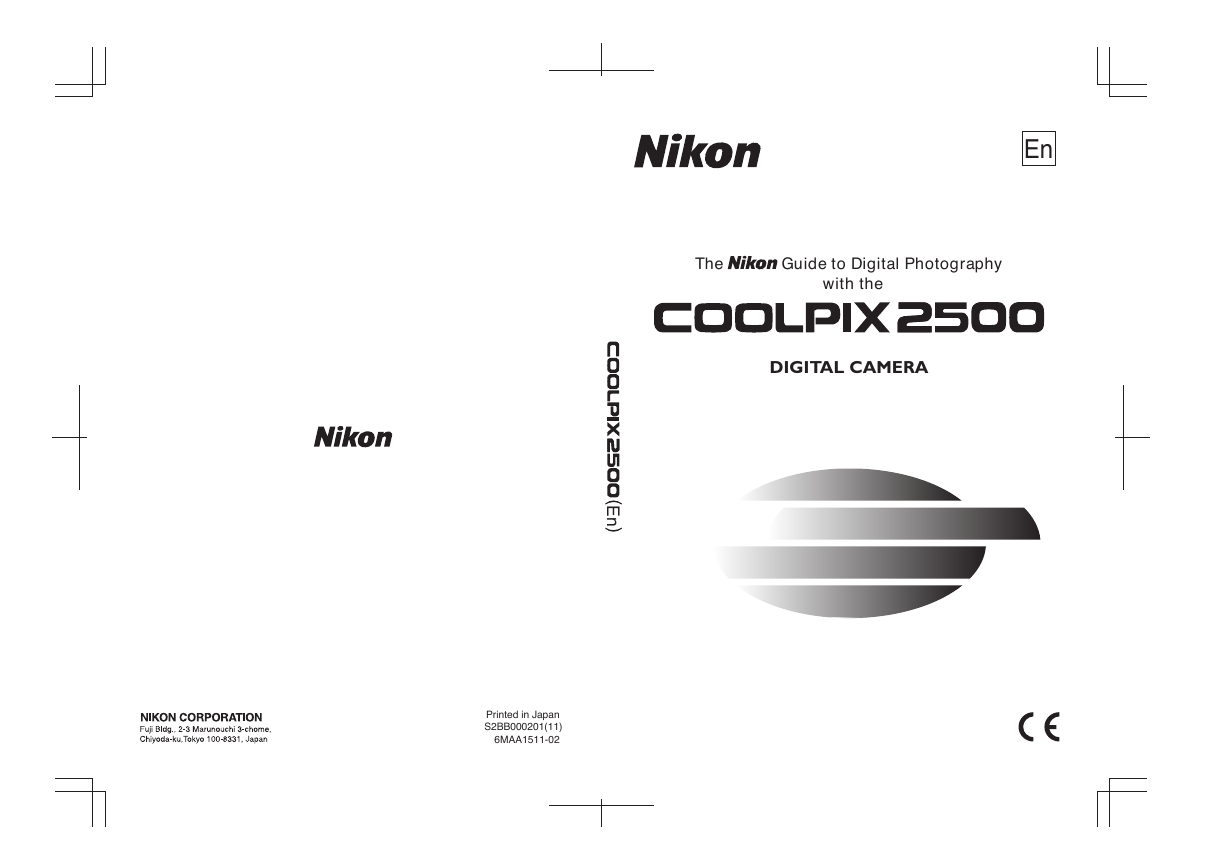
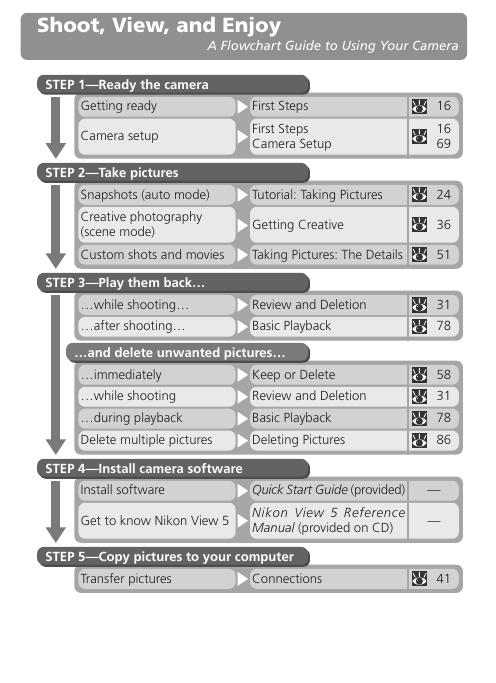
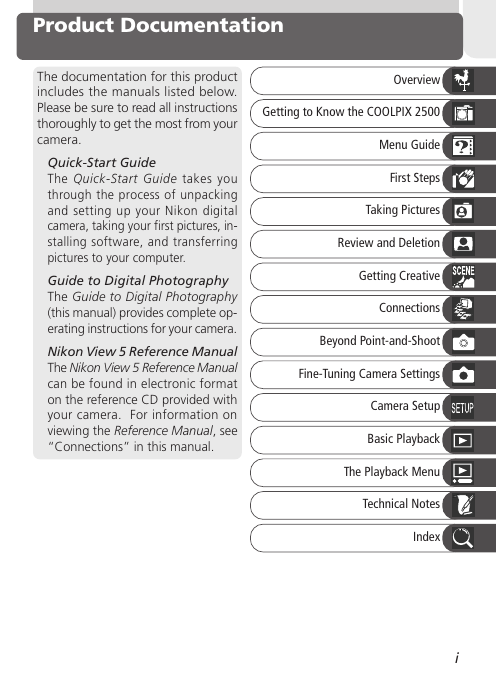
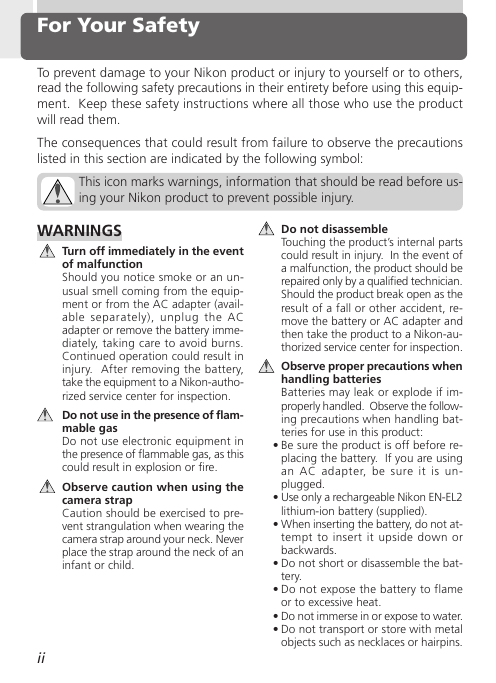
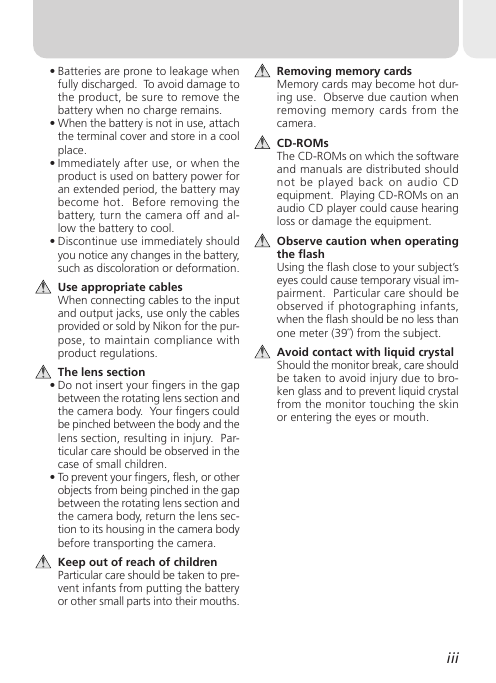
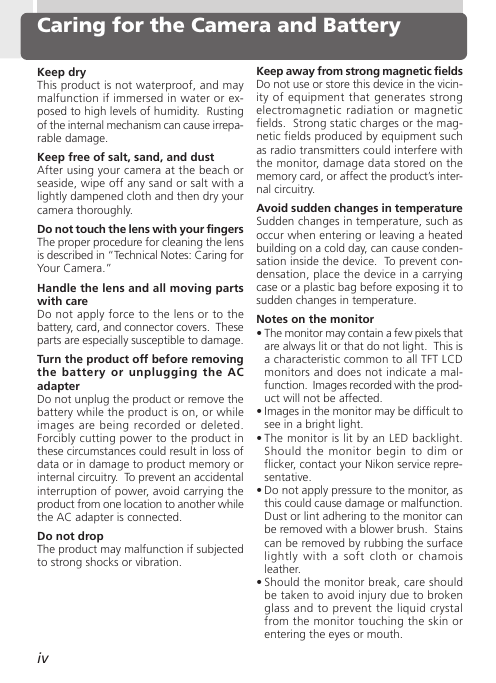
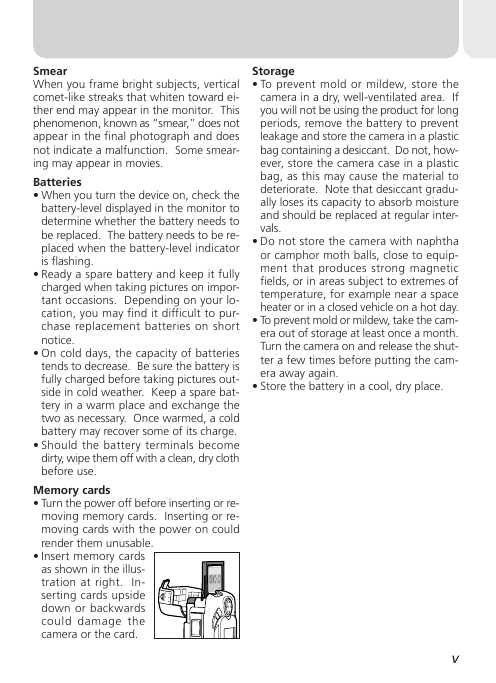
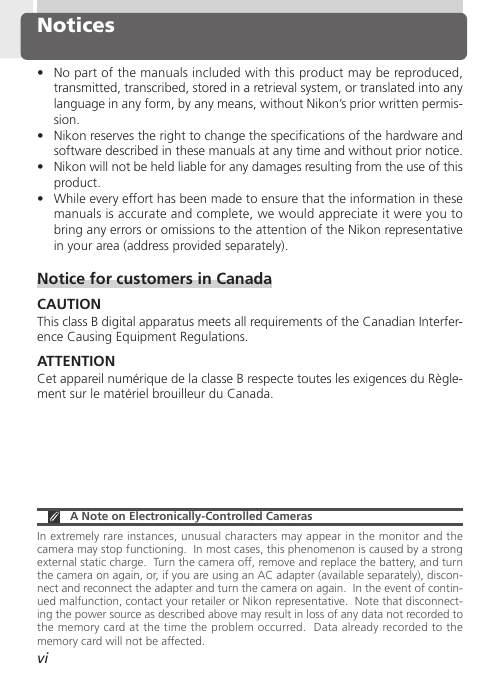








 2023年江西萍乡中考道德与法治真题及答案.doc
2023年江西萍乡中考道德与法治真题及答案.doc 2012年重庆南川中考生物真题及答案.doc
2012年重庆南川中考生物真题及答案.doc 2013年江西师范大学地理学综合及文艺理论基础考研真题.doc
2013年江西师范大学地理学综合及文艺理论基础考研真题.doc 2020年四川甘孜小升初语文真题及答案I卷.doc
2020年四川甘孜小升初语文真题及答案I卷.doc 2020年注册岩土工程师专业基础考试真题及答案.doc
2020年注册岩土工程师专业基础考试真题及答案.doc 2023-2024学年福建省厦门市九年级上学期数学月考试题及答案.doc
2023-2024学年福建省厦门市九年级上学期数学月考试题及答案.doc 2021-2022学年辽宁省沈阳市大东区九年级上学期语文期末试题及答案.doc
2021-2022学年辽宁省沈阳市大东区九年级上学期语文期末试题及答案.doc 2022-2023学年北京东城区初三第一学期物理期末试卷及答案.doc
2022-2023学年北京东城区初三第一学期物理期末试卷及答案.doc 2018上半年江西教师资格初中地理学科知识与教学能力真题及答案.doc
2018上半年江西教师资格初中地理学科知识与教学能力真题及答案.doc 2012年河北国家公务员申论考试真题及答案-省级.doc
2012年河北国家公务员申论考试真题及答案-省级.doc 2020-2021学年江苏省扬州市江都区邵樊片九年级上学期数学第一次质量检测试题及答案.doc
2020-2021学年江苏省扬州市江都区邵樊片九年级上学期数学第一次质量检测试题及答案.doc 2022下半年黑龙江教师资格证中学综合素质真题及答案.doc
2022下半年黑龙江教师资格证中学综合素质真题及答案.doc